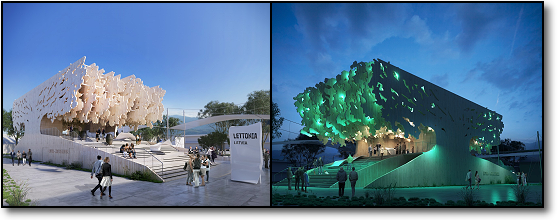|
|
||||
|
<< September
<< July/August
<< July/August
<< September
<< Nov/Dec 2014
<< June
<< June
<< Part I
(June/July)
<< June
<< June
<< June
<< Part I
(June/July)
* * * |
Milan Expo 2015: "Feeding the Planet, Energy for Life" The "World's Fair Express" began in the summer of 2014 as a part of the summer theme "The Art of Progress." Each of the major pages on the site is themed to a particular World's Fair/World Expo, beginning in the City of Light, Paris, in 1889. The path of each of the pages listed in the links above finishes with the last World Expo which was held in China in 2010. All this leads up to the celebration of the next World Expo which will open in Milan, Italy, in May of 2015. Modern World Expos last for six months and attract millions of viewers, but they also have evolved from their World's Fair roots. The Milan Expo will have a very focused theme, "Feeding the Plant, Energy for Life." The essays which will appear on the site between now and may will delve a little deeper into the content of the Expo and how the event will be addressing the theme. The schedule of the articles that will appear through May 2015 is included below.
February 2015 Essay "Feeding the Planet, Energy for Life: Global Participants (Part I)" With less than three months to go until the May 1st opening of Expo 2015 in Milan, Italy, construction of the facilities is proceeding at a rapid pace. The weekly "Belvedere in Citta" drone-based videos, which can be accessed from the Expo home page (www.expo2015.org), show exactly how the event grounds are beginning to take shape. The November/December 2014 essay provided background on World Fairs/World Expos in general, along with an introduction to this year's event, and the January 2015 essay provided additional background on the theme "Feeding the Planet, Energy for Life." Both of these essays can be accessed in the Essay Archives. For the next couple of months, attention will be turned to the participants in this global gastronomic gala. Milan and Italy may be the host city and country, but the event might more aptly be compared to an international Olympics of food, minus the competition. With many millions of people projected to visit the Expo, what might they expect to find? Some of the Expo host-created thematic areas which will set the stage for the overall visitor experience were described in the previous two essays. But by far the greatest percentage of any visitor's time at the event is likely to be spent visiting the self-built pavilions and multi-country cluster areas which will be home to the global participants. Expo participants are classifed by the Bureau International des Expositions (BIE) as being either official or non-official. As of February 1, the Expo participants page (www.expo2015.org/en/participants) lists the non-official participants as five corporate pavilions and thirteen non-governmental/civil society organizations, including Caritas, Fairtrade International, Lions Clubs International and Oxfam. Official participants include three international organizations such as the United Nations, plus the "heart" of the Expo, or "145 countries representing 94% of the world's population." (n1) [Note: It is not entirely clear where those numbers come from, as at last count only about 105 countries are specifically mentioned by name anywhere on the Expo site, and those countries do not include India, South Africa, Australia, Sweden and others which, when taken together, make up about 20% of the world's population). Countries participate in the event in either self-built pavilions or specifically-themed areas called clusters. Both will be described in greater detail below. The Clusters The theme "Feeding the Planet, Energy for Life" is one incorporating global issues affecting all of humanity. The organizers' design for the broadest possible participation has provided an option for countries to be included in small group areas called clusters rather than full one-country pavilions. For this Expo there will be nine clusters based on two criteria: food chains (six clusters) and thematic identity (three clusters). (n2) The six food chain clusters are rice, coffee, cocoa, cereals and tubers, fruit and legumes, and spices. The three thematic identity clusters will be Arid Zones, Bio-Mediterraneum and Islands, Sea and Food. In the clusters, the participants will take part in "one architectural project developed around a shared central theme to which each country will make its own personal contribution." (n3) In the food chain clusters the products, such as coffee or cocoa, may sustain a significant part of the country's economy and/or be of cultural, historical or nutritional significance. In the thematic identity clusters, countries tend to face the same or similar geographic or climatic circumstances which may influence agricultural production, food choices, or other cultural or social issues. The Expo website describes the architectural elements and other cluster details at greater length; a link to explore the cluster via the 3D virtual tour also is included with the information. A brief description of each of the clusters and participating countries (as listed on the Expo website as of February 1) is included below. Food Chain Clusters
Thematic Identity Clusters The three thematic identity clusters are inspired by the realities of food production and consumption in various ecosystems and regions. All three of these clusters will be located in the biodiversity park, a thematic area which will be a "garden spread over 14,000 square meters." (n16) The three thematic identity clusters and their participating countries (as listed on the Expo website as of February 1) are: Agriculture and Nutrition in the Arid Zones - The cluster, with architectural elements and designs inspired by the desert, will include Djibouti, Eritrea, Mauritania, Mali, Palestine, Senegal and Somalia. Islands, Sea and Food - The cluster, inspired by island and coastal life, will include Barbados, Belize, Cape Verde, the Caribbean Community Commons, Dominica, Grenada, Guinea Bissau, Guyana, Madagascar, Maldives, Saint Lucia, Saint Vincent and the Grenadines and Suriname. Bio-Mediterraneum: Health, Beauty and Harmony - The cluster, with a concept based on lifestyles of the Mediterranean region, will include Albania, Algeria, Egypt, Greece, Lebanon, Libya, Malta, Montenegro, San Marino, Serbia and Tunisia. Country Pavilions Further up toward the top of this page is a video combining archival photographs of the Paris Exposition Universelle, or the Paris World's Fair of 1889. Several images show the pavilions erected by various nations from throughout the world. Individual self-built national pavilions have been a central feature of World Fairs/World Expos for a major portion of their existence, and the Milan Expo is no exception. The U.S. Pavilion, with the theme "American Food 2.0," was introduced in the November/December essay and hopefully will be revisited again closer to the event's opening date. The introduction to these pavilions continues with the image below, the conceptual rendering of what the completed pavilion of the country of Latvia will look like, both during the day and at night. The pavilion will be designed as a giant oak tree, and the country's theme for the event is "The Apiary of Life."
Image: Latvia Pavilion by day (left) and night (right). Image courtesy of the Lativia Pavilion press kit, downloaded at www.latviaexpo.com/en/for-media/press-kit. The amount of planning which goes into each country's pavilion cannot be understated. To begin with, Expo organizers issued a series of rules and regulations which set the stage for the building of the pavilion. These included: 1) at least 50 percent of the lot [where the pavilion is built] must be in the open air and the Exhibition Space may be developed to a maximum height of 17 metres; 2) priority must be given to solutions that demonstrate energy efficiency and that use the exhibition target resources both in the building itself (by the use of materials that can be recycled and that have a low energy consumption) and during the Event (with strategies for the recovery and recycling of materials and refuse); 3) queues must be avoided at all costs so solutions that ensure an efficient flow of people through the Site must be designed and put in place. To help this, the possibility of using the open-air spaces should be explored, and any waiting time the visitor may have should be exploited; and 4) technology should be used to create efficient systems of info-mobility in order to co-ordinate management of the individual Exhibition Spaces with the overall Exposition Site. (n17) In addition, each participant was tasked with developing a "theme statement" outlining their particular choice for expressing the overall Expo theme (Feeding the Planet, Energy for Life) along four dimensions: concept and educational plan, architecture and technology, exhibits and active content, and commercial activities and food services. (n18) Other touches also are added by the host country to reflect the country's unique geography, customs and/or culture. In just under seven minutes, the video below encapsulates how all these elements have come together for one pavilion, that of the United Arab Emirates (UAE). The theme for the pavilion is "Food for Thought," and the design is partly inspired by patterns shaped by the wind in sand dunes. Another unique feature of the pavilion will be tablets given to visitors upon entry to help guide them through the exhibits. The tablets will be returned to the entrance of the pavilion by a constantly moving "stream" reminiscent of narrow irrigation channels which have been used in the country.
(If the video doesn't load, it can be viewed at www.youtube.com/watch?v=4UmsbUb5Gk0). The examples presented here are only the beginning of what is now taking shape in Milan. The second part of this look at some of the Expo participants will continue next month. Until then, those wanting to see more can visit the participants page via the link in the third paragraph of the essay above. Also, links to some of the individual country Facebook pages, Twitter pages and websites can be found at http://expo2015-milano.blogspot.com/2014/06/new-website-for-hungary-pavilion.html. Thanks for visiting the essay section this month, and please come back again in March! FOOTNOTES - The footnotes are indicated in the text in parentheses with the letter "n" and a number. If you click the asterisk at the end of the footnote, it will take you back to the paragraph in which the citation was located. n1 - Expo 2015 official website "Participants" page; viewed February 2015 at www.expo2015.org/en/participants. (*) n2 - Expo 2015 S.p.A., Theme Guide, Milan, Italy: Expo 2015 S.p.A., September 2012, p. 51. Pdf file downloaded October 2014 at www.expo2015.org. (*) n4 - Katz, Solomon H., editor in chief, Encyclopedia of Food and Culture, Volume 1, New York: Charles Scribner's Sons, 2003, p. 400. (*) n5 - International Cocoa Organization (ICCO), Annual Report 2012/13. London: ICCO, 2014, p. 3. (*) n6 - Food and Agricultural Organization of the United Nations (FAO), FAO Statistical Yearbook 2013: World Food and Agriculture, Rome, Italy: FAO, 2013, p. 160. (*) n7 - Katz, Solomon H., editor in chief, Encyclopedia of Food and Culture, Volume 3, pp. 197-198. (*) n9 - International Coffee Organization (ICO), Trade Statistics. Total production of exporting countries 2009 - 2014. Viewed online February 2015 at http://www.ico.org/trade_statistics.asp. (*) n10 - Expo 2015 website, Coffee Cluster: http://www.expo2015.org/en/explore/clusters/coffee. Viewed online February 2015. (*) n11 - Gillespie, Rosemary G. and Clague, David A. Encyclopedia of Islands, Berkeley/Los Angeles/London: University of California Press, 2004, p. 983. (*) n12 - Solomon, Encyclopedia of Food and Culture, Volume 2, p. 188. (*) n13 - FAO, FAO Statistical Yearbook, p. 77. (*) n14 - Expo 2015 website, Fruits and Legumes Cluster: http://www.expo2015.org/en/explore/clusters/fruits-and-legumes. Viewed online February 2015. (*) n15 - McCoy, John F., Project Editor, Geo-Data: The World Geographical Encyclopedia, 3rd Edition, Farmington Hills, MI: Gale/The Gale Group, Inc., 2003, p. 199. (*) n16 - Expo 2015 S.p.A., Theme Guide, p. 51. (*) LINKS LIST - The list of links external to the website found in the essay.
BIBLIOGRAPHY - The bibliography for the February 2015 essay is included below. Expo 2015 - "Coffee Cluster" web page, viewed online February 2015 at www.expo2015.org/en/explore/clusters/coffee. Expo 2015. "Explore/Clusters" viewed online October 2014 at www.expo2015.org/cs/Expo/en/explore/clusters. Expo 2015. "Participants" page, viewed online February 2015 at www.expo2015.org/en/participants. Expo 2015 S.p.A. Theme Guide. Milan, Italy: Expo 2015 S.p.A., September 2012. Food and Agricultural Organization of the United Nations (FAO), FAO Statistical Yearbook 2013: World Food and Agriculture, Rome, Italy: FAO, 2013. Gillespie, Rosemary G. and Clague, David A., Encyclopedia of Islands, Berkeley/Los Angeles/London: University of California Press, 2004. International Cocoa Organization (ICCO), Annual Report 2012/13, London: ICCO, 2014. International Coffee Organization (ICO), Trade Statistics, Table: Total production of exporting countries 2009 - 2014. Viewed online February 2015 at http://www.ico.org/trade_statistics.asp. Katz, Solomon H., Editor in Chief, Encyclopedia of Food and Culture, Volume 1, New York: Charles Scribner's Sons, 2003 LatviaExpo.com. Press Kit, Latvia Pavilion, viewed online/downloaded February 2015 at www.latviaexpo.com/en/for-media/press-kit. McCoy, John F., Project Editor, Geo-Data: The World Geographical Encyclopedia, 3rd Edition, Farmington Hills, MI: Gale/The Gale Group, Inc., 2003. To return to the top of the page, click here. To return to the essay archives, click here.
Follow www.dorothyswebsite.org on TWITTER! Home |
Essays | Poetry | Free Concerts | Links | 2019 Extras |
About the Site |
|||
|
www.dorothyswebsite.org © 2003 - 2019 Dorothy A. Birsic. All rights reserved. Comments? Questions? Send an e-mail to: information@dorothyswebsite.org | ||||















